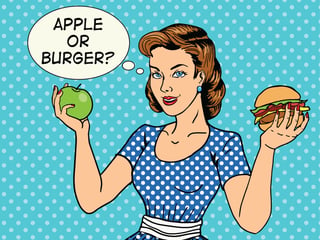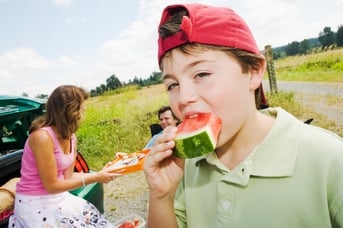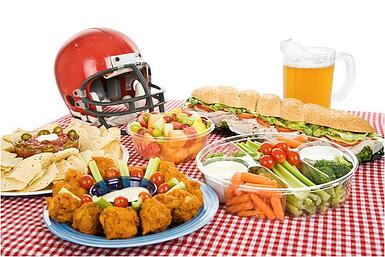 The other day I went out to dinner at a restaurant to celebrate a friend’s recent work promotion. Being a health-conscious person, I ordered grilled chicken and a salad with a small glass of wine. As I handed my menu to the waiter, my friends commented about how I didn’t “need a salad” and that I should “eat what I want” because I exercise enough.
The other day I went out to dinner at a restaurant to celebrate a friend’s recent work promotion. Being a health-conscious person, I ordered grilled chicken and a salad with a small glass of wine. As I handed my menu to the waiter, my friends commented about how I didn’t “need a salad” and that I should “eat what I want” because I exercise enough.
I laughed off the comments and said I was trying real hard to practice what I preached (they all know I am a health coach, after all). Plus, if I wanted a cheeseburger and fries, I would order them. Everything in moderation, right?
Dessert: A Food-Choice Hot Button
When it came time for dessert, the conversation quickly turned to questions about who was going to order what. Maybe I was feeling a little sensitive because of the comments about my earlier food choices, but it seemed like my friends were looking for validation rather than simply wanting to know what my dessert of choice would be. I ordered a small sundae, not because I wanted something sweet, but because I didn’t want to seem like the odd one out.
Toward the end of the meal, one of them pointed out that I had only a few bites of my sundae and declared I was “making her feel terrible” for eating cheesecake. This seemed to open the floodgates for the rest of my friends, who were apparently thinking along the same lines:
“A piece of cake won’t kill you!”
“Look at you being all healthy and stuff.”
“Are you trying to show us up?”
“Don’t you want to have a good time with us?”
“You’re making us all look fat!”
“You used to be way more fun!”
The comments persisted. Other dessert plates were pushed toward me. More wine poured in my glass to help me “relax” and “enjoy myself for once.” I stood my ground, saying I felt full; but looking back, it’s hard to tell if I was really full or if the conversation had caused me to lose my appetite.
Health Shaming Is Real…and Impacts Motivation
My clients have told me how difficult it can be to make healthy choices when your family and loved ones don’t have similar nutrition and fitness goals, but I had never experienced that type of peer pressure or “health shaming” until this night.
Skinny shaming…fat shaming…health shaming…how many of you have experienced something like this? How have you responded? How do you make healthy choices when you’re surrounded by people who don’t share your goals?
Related:
- Are Recent Changes to Restaurant Menu Ingredients Good for You?
- Get Family and Friends Involved in Your Fitness Goals
NIFS Registered Dietitian shares the top four app for healthier eating, download the quick read below to help you stay on track with your desired choices. Be proud of your decision to make healthy choices!


 You know you want and need to have a regular plan for your exercise, but where do you begin to
You know you want and need to have a regular plan for your exercise, but where do you begin to
 March is National Nutrition Month! It may be time to revisit and reestablish your New Year’s diet resolutions. I wanted to pass along a basic guide to healthy eating and lifestyle habits that can also be used for weight loss.
March is National Nutrition Month! It may be time to revisit and reestablish your New Year’s diet resolutions. I wanted to pass along a basic guide to healthy eating and lifestyle habits that can also be used for weight loss.  The next fad diet may work, but what happens afterward? Do you continue that system forever? Should you follow a program designed for weight loss if you’re
The next fad diet may work, but what happens afterward? Do you continue that system forever? Should you follow a program designed for weight loss if you’re 
 Whether you are traveling for business or for pleasure it typically means most meals are eaten out or on the go. This can be challenging to make the most balanced choices and keeping your eating on the right track. You want to try foods special to that region, you are busy and grabbing the first thing that sounds good, you don’t have access to a grocery store for more fresh foods can all be challenges while traveling.
Whether you are traveling for business or for pleasure it typically means most meals are eaten out or on the go. This can be challenging to make the most balanced choices and keeping your eating on the right track. You want to try foods special to that region, you are busy and grabbing the first thing that sounds good, you don’t have access to a grocery store for more fresh foods can all be challenges while traveling.
 It’s that time of the year again: football season. With every year comes a clean slate for each team. Rosters are changed, stars have yet to emerge, and the underdog team is nowhere close to being discovered. With the changes the football season brings, have you ever considered your dietary habits for the season? Similar to the new football season ahead, do you plan to change your eating or drinking habits for football Sunday?
It’s that time of the year again: football season. With every year comes a clean slate for each team. Rosters are changed, stars have yet to emerge, and the underdog team is nowhere close to being discovered. With the changes the football season brings, have you ever considered your dietary habits for the season? Similar to the new football season ahead, do you plan to change your eating or drinking habits for football Sunday?
 We see
We see  The
The  Juicing is the process of extracting juice from the flesh or the pulp of a fruit or vegetable. This technique has been used for hundreds of years as a way to maximize nutrient intake by drinking only the juice of various vegetables and fruits. I wanted to get the New Year off to a healthy start and reset my digestive system, so I researched how to complete a “safe” juice cleanse.
Juicing is the process of extracting juice from the flesh or the pulp of a fruit or vegetable. This technique has been used for hundreds of years as a way to maximize nutrient intake by drinking only the juice of various vegetables and fruits. I wanted to get the New Year off to a healthy start and reset my digestive system, so I researched how to complete a “safe” juice cleanse. This time of year many people are looking to drop excess weight. In their desire to see rapid results, many start a supplement program such as
This time of year many people are looking to drop excess weight. In their desire to see rapid results, many start a supplement program such as